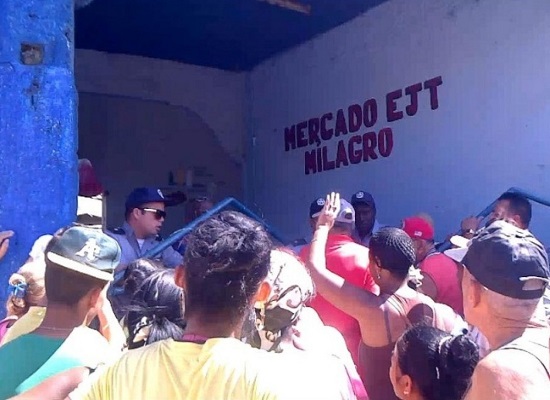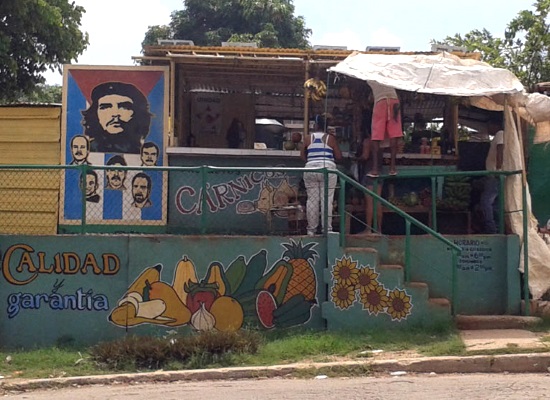
Cubanet, Miriam Celaya, HAVANA, 6 November 2015 — Hopes and expectations that encouraged Cubans at the beginning of 2015, following the announcement of the restoration of relations between the governments of Cuba and the US, have vanished completely. Over the past eleven months there has not been a hint of any economic improvement for the population, and the end of the year is expected to be grim, judging by, among other factors, rising prices in the food sector, our most important market.
Visits around numerous commercial shops and roving street markets in the populous municipality of Centro Habana, in the neighborhoods of San Leopoldo, Pueblo Nuevo and Cayo Hueso, evidence the shortages in merchandise, the low quality of products and the unstoppable rise in prices. Pork meat – the Cuban indicator par excellence –– fluctuates between 45 and 50 pesos per pound; while black beans go for 10 to 12 pesos. Other grains are priced beyond the reach of most pockets. The price for one pound of red beans has reached 17 pesos, while white beans cost between 18 and 20, and the price of chick peas has risen to 22.
Meanwhile, greens and vegetables are competing in this amazing climb. A pound of tomatoes at the San Rafael market costs 25 pesos; bunches of carrots or beets – a variable, indefinite and inaccurate national-trade measure — are priced at 20 pesos, same as a pound of small onions and peppers, placed on pallets next to the also stunted cabbages, advertised at 15 pesos apiece. Avocado prices may fluctuate between 7 and 10 pesos apiece. However, during the weekends it reaches up to 12 pesos.
Tubers and other vegetables are not beyond the amazing rise in prices. Thus, a pound of taro costs 8 pesos, twice the price of yucca and yams, which are between 3 and 4 pesos. Small to medium plantains sell for 4 pesos apiece.
A quick calculation, taking as a base the so-called Cuban average income – between 400 and 450 pesos (around $23 U.S.) per month, according to official data — results in the obvious conclusion that the purchasing power of the median active labor force has continue to decline, not to mention the growing aging demographic sector, dependent on miserable retirement pensions, or aid from relatives, when they can afford to help, or on the solidarity of some nice neighbor who might occasionally offer a plate of food. Getting a full meal in Cuba has virtually become a true luxury.
Few differences exist between one retail outlet and another, and between the municipalities in the capital. The last four months of the year have shown the highest increases in food prices to date, for a population whose incomes, whether stemming from salaries, retirement funds, remittances from relatives living abroad, or some other source, is increasingly inadequate, not only to satisfy living demands, but insufficient to cover the barest necessities: food, clothing, footwear and shelter.
More than four years have transpired since the ‘updating of the model’, with government experimentation in the retail sale of agricultural products by ‘self-employed’ sellers (pushcart vendors) as well as by non-state cooperative farmers markets, and the upward trend of food prices, far from ceasing, has accelerated its rate, which indicates a failure in the official plans for this important issue – production and commercialization of foodstuffs to satisfy the needs of the population and at the same time replace imports — which was one of the most important items in the guidelines of the April 2011 Sixth Congress of the Cuban Communist Party (PCC).

The internal situation in Cuba, with its shortages and deficiencies in an ascending mode is looking increasingly more each day like the situation we endured in the 90’s, following the collapse of that house of cards which was once called “the Socialist Camp”. At the same time, the Cuban people’s discontent, despair, and the stampede overseas continue to grow.
The bubble of dreams awakened last December has been popped by the stubborn reality of a system designed for the benefit of the hired applauders who cling to power and to the submission of the rest of society. A general feeling of frustration continues to rise in Cuba, but nobody seems to know how to channel disappointment except by escaping, by any means, from this life-sentence of misery.
Paradoxically, the spiral of poverty that marks everyday life on the Island seems to be the most effective weapon of the regime to maintain social control to date. And, while ordinary Cubans, unaware of tomorrow, continue to rummage with resignation from one market to another, foraging among the small dirty pallets for their scarce daily food, flocks of raptor merchants arrive from overseas to the International Fair of Havana so they may fight for any good slice that the spoils and the ruins of the national-failure-converted-into-merchandise, by guerrillas-turned oligarchs, might offer them. The capital celebration has once again opened its doors in Cuba, but we Cubans are not invited.
Translated by Norma Whiting
